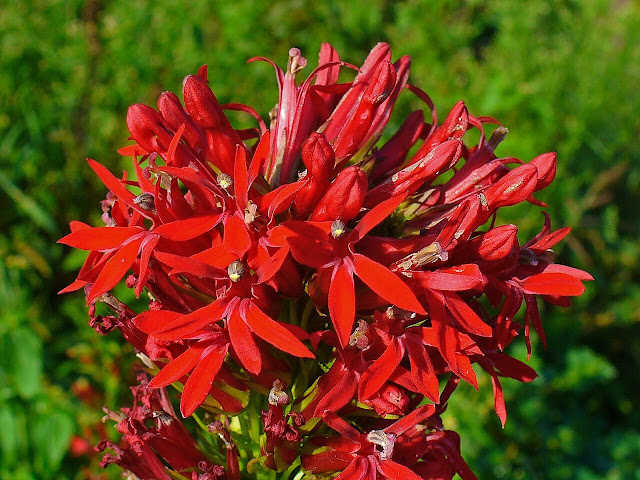These bright red flowers that grow up to six feet on spikes are hard to miss. This wildflower is native to North America and grows in marshes, along stream banks, and in damp woods. It is a special flower because few native herbaceous perennial plants have such intense color. It is easy to see why Native American communities were attracted to these showy flowers and found ways to use this plant medicinally.
 |
| courtesy Paquet, Mélodie |
This flower is a member of the Bluebell Family and is found in much of the United States including Connecticut and eastern Canada. The National Plant Data map shows that it doesn't grow in Oregon, Washington, Idaho, Wyoming, Montana, or North and South Dakota. This plant's scientific name is Lobelia cardinalis. It grows from a rhizomatous and fibrous root system and is considered to be a wetland plant. The tubular-shaped scarlet flowers bloom on tall sturdy ridged spikes in the late summer and split into 2 lobs on the top that flare out and three lobs on the bottom of the bloom that droop down. There are five stamens which are joined together forming a red tube around the style. The tube is topped by bearded anthers to form a grayish brush. This plant is pollinated by hummingbirds and bumblebees. The tapered dark green leaves are lance-shaped, the upper leaves are finely toothed and the lower leaves have more prominent teeth. The seed capsules hold two seeds and open to disperse them to the wind allowing the plant to self-seed. Cardinal flowers bloom until the first frost.
 |
| courtesy Stan Shebs |
Medicinal Uses
Red cardinal plants are tricky to use medicinally because their juice is milky and acrid, some people are allergic to the sap if it touches their skin. If eaten in large quantities, all parts of this plant, especially the flowers, are toxic. That said, Native American communities used this plant medicinally. One of the most common uses was to make tea to treat stomach problems and to treat colds, pain, and fever. Traditionally, the Cherokee used this plant as an analgesic and would pound the leaves into a poultice to treat a headache. They also made an infusion of the leaves to treat rheumatism, fever, colds, and stomach trouble. The roots were pounded and taken to get rid of worms. The Delaware made an infusion from the roots to treat typhoid, while the Iroquois used an infusion or poultice of roots to treat pain, fever sores, and fevers. The Iroquois made a decoction of the plant to treat consumption and stomach troubles and as pain relief for breast trouble, and menstruation. The Zuni used parts of this plant as an ingredient in schumaakwe cakes that were eaten to treat rheumatism and extreme swelling.
 |
| courtesy Ayotte Gilles |
The Iroquois made an infusion of the roots that was used as a wash for love medicine. The Meskwaki ground the roots of this plant and put it in food to end quarrels and prevent divorce. They also made tea from the root and drank it as a love medicine. The Pawnee made a compound of the roots and flowers and used it as a love charm.
The Iroquois made an infusion of the roots and drank it to treat the trouble caused by witchcraft.
The Iroquois made a special infusion of the flowers and stalks and washed baskets with the mixture.
 |
| Red Cardinal is one of North America's most colorful flowers |
The Cardinal Flower was named after Flemish botanist, Matthias de L'Obel who lived from 1538 - 1616. When he moved to England as a doctor to King James I, he changed his name to Matthew Lobel, hence the name of this plant.
Folklore indicates that this plant is named cardinalis for the red color of the robs worn by Cardinals of the Catholic Church.
The flowers attract bees, butterflies, and hummingbirds.
Cultivated in Europe since the 1600s, the English believed that if an elder woman touched the roots of this plant it would bring love into their lives.


.jpg)
No comments:
Post a Comment